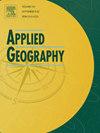Multiple local co-agglomeration: Modelling spatial-temporal variations of coworking spaces and creative industries clustering in two central European Capitals
IF 4
2区 地球科学
Q1 GEOGRAPHY
引用次数: 0
Abstract
Economies of agglomeration play a crucial role in the creation of innovation in regional innovation systems. In the last decade, coworking spaces have become an organisational innovation of the sharing economy in these systems. Therefore, research on spatial co-agglomeration between coworking spaces and service industries is rising, identifying creative industries as the most significant services for colocation with coworking spaces. Previous studies on spatial association between coworking spaces and service industries have focused on the global distance measurement of their co-agglomeration. Hence, the paper provides insight into the extension of the research by comparing two cross-sectional datasets at different times by locally measured multiple colocations between coworking spaces and the selected creative industries in Prague and Warsaw. The present study is expected to contribute to understanding the spatial association in the long-term trajectories of coworking spaces with creative industries. The results underline the importance of the usage of local colocation quotients in space-time perspective for the detection of spatial association between coworking spaces and creative industries for determining trajectories of their spatial interactions, which resulted in both intensification and spatial diffusion of CBD functions in the adjacent inner city and along urban arterial roads supporting the polycentric metropolis model.
多重地方聚集:欧洲中部两个首都的协同工作空间和创意产业集群的时空变化建模
集聚经济在区域创新体系的创新创造中发挥着至关重要的作用。在过去十年中,协同办公空间已成为这些系统中共享经济的一种组织创新。因此,有关协同办公空间与服务业空间协同集聚的研究正在兴起,并将创意产业确定为与协同办公空间集聚的最重要服务业。以往关于协同办公空间与服务业空间关联的研究主要集中在协同集聚的全球距离测量上。因此,本文通过比较不同时期的两个横截面数据集,对布拉格和华沙的协同工作空间与所选创意产业之间的多重聚落进行了本地测量,从而为研究的扩展提供了深入的见解。预计本研究将有助于理解协同工作空间与创意产业长期轨迹中的空间关联。研究结果强调了从时空角度利用本地同位商数检测协同办公空间与创意产业之间空间关联的重要性,以确定它们的空间互动轨迹,这导致 CBD 功能在邻近内城和城市干道沿线的强化和空间扩散,支持多中心大都市模型。
本文章由计算机程序翻译,如有差异,请以英文原文为准。
求助全文
约1分钟内获得全文
求助全文
来源期刊

Applied Geography
GEOGRAPHY-
CiteScore
8.00
自引率
2.00%
发文量
134
期刊介绍:
Applied Geography is a journal devoted to the publication of research which utilizes geographic approaches (human, physical, nature-society and GIScience) to resolve human problems that have a spatial dimension. These problems may be related to the assessment, management and allocation of the world physical and/or human resources. The underlying rationale of the journal is that only through a clear understanding of the relevant societal, physical, and coupled natural-humans systems can we resolve such problems. Papers are invited on any theme involving the application of geographical theory and methodology in the resolution of human problems.
 求助内容:
求助内容: 应助结果提醒方式:
应助结果提醒方式:


